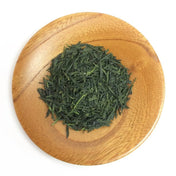by Chris Weiss

A few weeks ago, I had the pleasure of visiting the Kinezuka family of Naturalitea for a weekend at their organic farm located in Fujieda, Shizuoka Prefecture, Japan. Although now a conglomeration of more than 26 member farms in the area that work to further organic farming techniques, father and founder Toshiaki Kinezuka helped start this organic tea group in 1976 in an effort to grow tea without harmful pesticides. Intended as a visit to learn an overview of organic tea growing and to partake in the processing of Japanese black tea (紅茶, or koucha), the event developed into something more emotive and memorable. Moving beyond a simple educational capacity, friendships were formed and even the ritualistic tasks like tea picking, embodied within the daily routine of family and tea life itself, gave rise to something much more real and meaningful than simply watching the production of a commodity good unfold.



Saturday morning began with a little over 30 of us hand-picking the tea in the Kinezuka family's organic tea fields located in the quiet and warm hills of Shizuoka (the kanji for Shizuoka, 静岡, indeed means exactly that: 'quiet hills'). Hand-picking tea leaves for processing is both meticulous and time consuming, as one must take care to pick only the top three leaves (the new bud and 2 leaves below it). It is these leaves, the youngest and tenderest of the new growth from the trees, that make the best tea and develop the most desirable flavors when steeped. While we picked, I exchanged stories with the four other pickers who spoke fluent English, and engaged in an educational and impassioned discussion on food sovereignty with Ayumi Kinezuka, daughter of Toshiaki Kinezuka, who had studied in the US for many years and now helps the family farm. As it turned out, unsurprisingly, many of the people I engaged with had come for the weekend visit not only because of their passion for tea, but also because they desire a transformation in what they see as the current agricultural paradigm: less reliance on pesticide use and the demands of public companies as well as the inherent rights of local people and producers to define their own agricultural systems1.



As noon rolled around, we took to the shade for a lunch break and to pass around pitchers of iced sencha (the green tea for which Japan is specifically known) grown right there at our footsteps. As tea plants grow best in higher elevation hillsides, it was comical to see a group of some 30 adults and a handful of young children balance themselves on a steep slope while enjoying their food. More so was the seeming (wonderful) absurdity when the workers pulled out a box of beautiful, ceramic cups (traditional Japanese yunomi) that were passed down the hill one-by-one until each person had their own cup of tea. My mind faintly imagined a similar experience where in the US a 5 gallon jug of tea and a sleeve of 50 plastic cups would have sufficed for each individual to fetch for themselves. Even after working together to pick tea in the sun, the lunch-time camaraderie between everyone made the experience that much more quaint, as everyone continued to work together to ensure everyone else's needs were continually met.



Once everyone had their own tea, we toasted and enjoyed our meals. I brought the tea to my lips and savored the first sip: it was sweet and flavorful, grassy but not overpowering, with a slightly roasted flavor that was incredibly refreshing in its iced form. Once one has experienced locally grown and freshly made tea, it is incomparable to any other experience from the tea bought sitting on a store shelf. As lunch concluded and we again reverse-passed all our cups delicately back to the box and cleaned up, we made our way again around the tea fields for a short discussion on the methods and differences between organic and conventional tea farming.
Nearby their own tea fields were conventional tea fields, where Ayumi elucidated on the strong differences between the teas that NaturaliTea produce and the teas of general, conventional growers (as a note, though conventionally grown nearby the Kinezuka's fields, they place barriers during spraying season and have tested their teas for residual pesticides that may come from farms nearby and indicated none have been found). The bushes of conventionally grown tea look bigger, taller, and slightly more uniform. There's also no hay or dark, organic matter that's been laid along the ground to prevent weeds from growing and nourish the plants, probably because some of the chemicals reduce competitive plant-growth already.
In addition, there were fewer insects to be seen, which from one perspective may be seen as a boon: there's no insect competition and yield is higher. However, from the perspective of the Kinezuka family this isn't a positive indication. Not only does it reduce biodiversity for a variety of plants and insects, but it also harms the desirable characteristics they want to cultivate in a tea plant by slowing the oxidation of the tea leaf once picked (in the case of black tea). In another case, it prevents the unka, or Japanese leaf hopper bug, from living on the plants. In many related scientific case studies of similar bugs (Jacobiasca formosana) in Taiwan, the tea plants produce compounds in reaction to being bitten by the leaf hoppers, which give the distinct characteristic flavor to the oolong tea known as oriental beauty. Ayumi argues that the ability of the leaves to wither and oxidize (hindered by pesticides), as well as the unka, are extremely important to the production of Japanese tea and specifically Japanese black tea, for which the tea plant cultivar (usually varietal yabukita) has generally been accepted as unsuitable for producing by the larger tea growing community.

After a few more hours of tea picking, the haul was brought back to the farm house and processing facility: two giant cloth sacks about halfway full that could be slung over a person's shoulder, totaling maybe (as my own estimate, I don't recall the actual amount) 60 pounds of fresh (unfinished) tea leaves – not nearly enough to be worth processing by the heavy machinery to be turned into black tea. To put this in perspective, in China a family of five may hand pick about 15 pounds of finished tea in a day2 . Tea leaves lose about 80% of their weight when they are processed from unfinished (raw leaf) to finished (dry) leaf, meaning that family of five picked perhaps 75 pounds of fresh leaves that day; 30 of us, working casually for a few hours, picked probably less than that. To supplement our handpicking, mechanical trimmings from earlier that day were added to provide the rest of the amount necessary to process the tea.



Because black tea needs time to wither, oxidize (react with oxygen to begin decomposing, a step necessary to create the the flavors that make a characteristic black tea), and ferment, the piles were left in the processing facility overnight to be processed the next morning. However, even upon bringing the the leaves back from the fields that were picked after the mechanically processed leaves, the hand-picked leaves had already withered more substantially and taken on a more characteristic floral odor. This quality emphasizes the importance in handpicking: not only are better leaves selected (mechanical chopping tea leaves around the world takes more than just the top 3 leaves and often includes stems and older, bigger leaves with less flavor, though Japan's mechanical technology is known for it's quality in this area), but picking by hand gently bruises enough of the leaves to help begin the tea process instantly. With this in mind, it only made me appreciate more the tea that is grown and picked by hand across the world over, often in much hotter and arduous working conditions, that creates the tea that eventually ends up in our cups.




While we left the leaves to wither overnight, everyone came together for dinner and enjoyed a homemade meal crafted from the food grown either on the farm or by their neighbors. Not only specializing in tea, NaturaliTea branches into other areas of organic food growing and animal husbandry, from growing their own rice for consumption and miso production, umeboshi trees for pickled plums, a variety of other crops and chickens for eggs. As we sat on zabuton (floor cushions) at low-seated tables and exchanged stories of who we were and the history and trajectory of where NaturaliTea saw itself progressing, the topic of food sovereignty was again broached, and the importance of healthy and culturally appropriate food (and tea) on the forefront of peoples' minds2. It again reminded me that during moments like those, when a group of people come together with a common goal and passion for change, meaning is both created and felt on a very visceral level.


The next morning, we returned to see how the tea had progressed in withering and to finish it into dry leaf. The tea smelled even more substantially of floral scents, but again the difference between the handpicked and machine cut lots were significant. After being processed through large, wooden machines that bruise the leaves for final processing into black tea (green tea is dried as soon as it is brought in from the fields to halt oxidation and keep the tea green), the leaves were run through two sets of driers to finish the tea: the first to remove the bulk of the moisture from the leaves and the second to completely dry the leaves for packing and aging. Contrary to green tea, which is best drunk as close to when it is finished as possible for the best flavor, teas like black, oolongs, and pu-erhs may benefit from further aging for months to years at a time since slight changes and fermentation are still going on within the leaves.


After the tea was finished, we all gathered around and cupped the tea to give it a try: it was indeed quite definitely a black tea, produced from the Japanese yabukita plant varietal, and had its own, unique taste even within the realms of black tea. Light and floral, it was slightly heavier than a green tea, and refreshing when served as an iced tea for breakfast that morning. Having finished the weekend of black tea processing from start to finish, the group of us reveled in tasting the final product of something we helped create. While the effort of growing and maintaining the organic acreage goes with great thanks to the NaturaliTea family, knowing that we took part in creating the drink that our palates were enjoying somehow made the tea embody that much more value. It made me greatly appreciate those moments and the opportunity to immerse myself with those around me who are seeking more meaning and justice in a broken agricultural system, beginning with something as simple as a cup of tea.
- Based on the Declaration of Nyéléni from the Forum for Food Sovereignty in Mali, 2007: https://nyeleni.org/spip.php?article290
- Verdant Tea, “Transparency in the Tea Industry: The Cost of Labor”: http://verdanttea.com/transparency-in-the-tea-industry-cost-of-labor/
Chris Weiss currently lives in Fukushima, Japan, and is interested in food and tea culture across the world with a strong love for Japanese sencha and traditional washoku. Questions and comments can be directed to chrisweissphoto@gmail.com. The reflection and statements of this article are of the opinion of the author and do not necessarily reflect NaturaliTea or Matcha Latte Media. Click here for more information on NaturaliTea.


